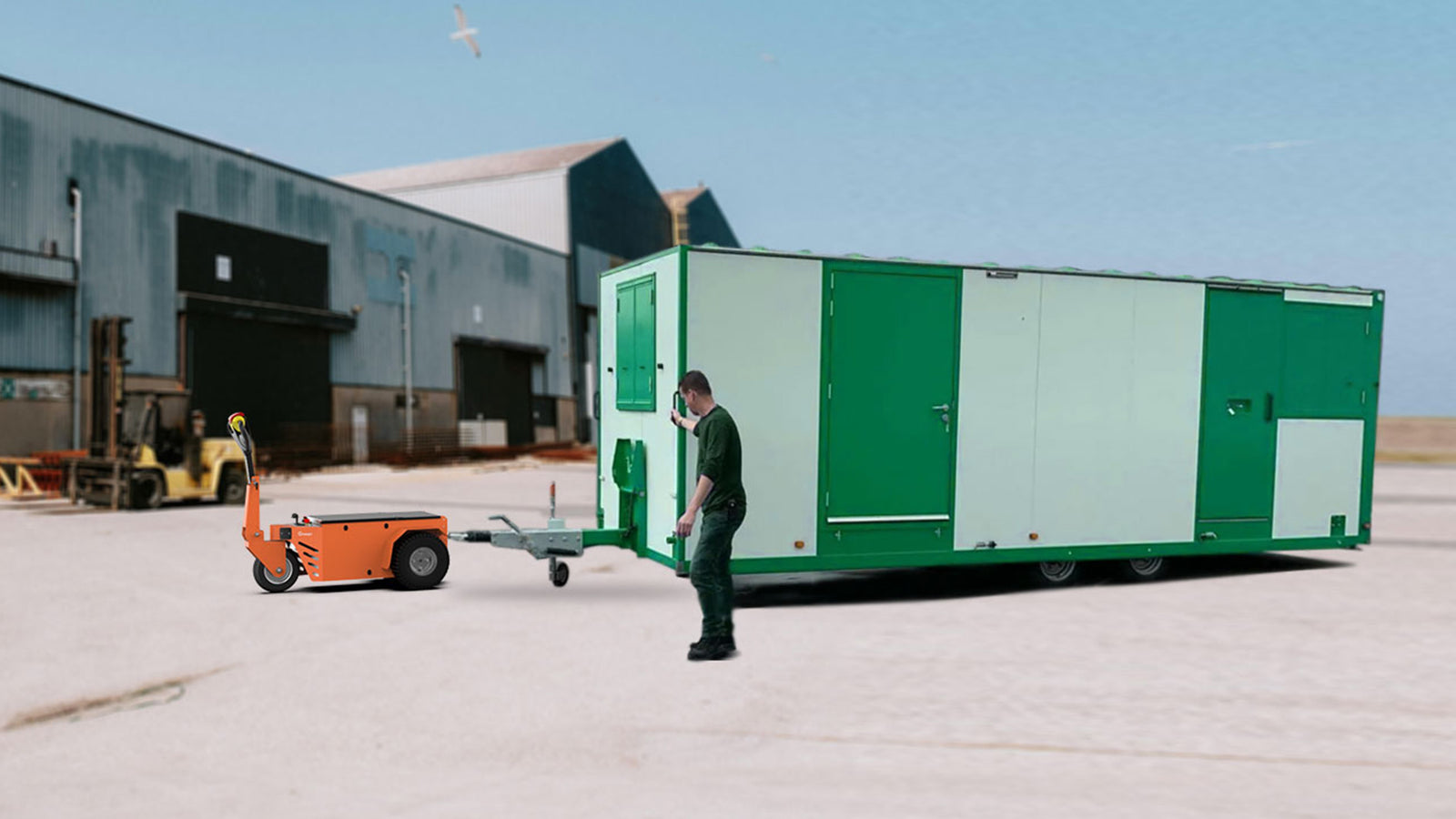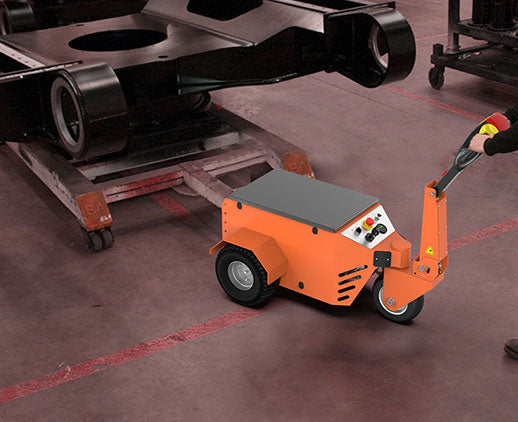Discover the 5 Key Benefits That Make AGVs Popular in Material Handling

Enhanced Maneuverability
Walk-behind AGVs are designed to be the solution of choice when excellence is needed in sectors where operations take place in constrained spaces and environment require agility. Thanks to their small footprint and advanced steering features, these vehicles are able to circulate in narrow alleys and cover tight angles up to a point when they can be used in retail, pharmaceutical, and manufacturing sites. Indeed, these sites obviously contain many points with congested spaces, and they require their load to be moved at all time with great precision.
Location where the use Walk-behind AGVs are Preferred
Retail Warehouses: In retail, storage spaces often lack space and alleys tend to be crowded. As walk-behind AGVs do not require any space to be able to negotiate these locations, they are the vehicle of choice to carry the goods from the stock room to the shelves or the sorting area without requiring any previously existing built-in bulky equipment.
Pharmaceutical Manufacturing: Most of the pharmaceutical manufacturing sites contain at least one clean room or restricted room, where contaminating the manufactured good should absolutely be avoided. Walk-behind AGVs enable to ensure that strict requirements are met, as these vehicles have a high level of precision. The facility’s sensitive materials can be handled without threatening contamination of the room.
Automotive Assembly Lines: Automotive is an industry where the need to move components forward on a regular basis from one assembly station to the other is a frequent routine. Walk-behind AGVs can be designed to follow this line. They can deliver the components “just in time,” which is particularly convenient given that one car can require components produced in different countries. This enables companies to reduce space used for pre-assembly storage and to avoid common human errors associated will this task.
Operational Benefits
Quick Implementation: Walk-behind AGVs are easy to implement and quickly put and use, thus to implement into existing operations. There is barely any down time when a site has to change the volume of its production or the nature of their good, as the AGV can be quickly programmed to be in full working function.
Reduced Strain: Since they handle the outmost important and strain full process, workers are able to avoid physical injury due to handling transportation and load issues. This means that they are more likely to be healthy and stay longer on site, thus acquiring more skill and being more productive overall.

User Control and Flexibility
Walk-behind AGVs’ operation is directly controlled by the operator, giving it more flexibility and adaptability in varying operational environments. This operation-state is vital for industries that must have equipment that meets changing conditions quickly. Thus, below are benefits of using a direct control system.
Immediate reaction
Operators can move the walk-behind AGVs manually, allowing them to have immediate shifts to fill when any need arises. This is critical in dynamic operational environments in a distribution center or a live production area. Avoiding obstacles or driving around layout changes can be done within a second to ensure the operation is consistent. If there is any waiting period for systematic missions to rerun, the duration of stopping and delays may later amount to hours of lost time. Resultantly, immediate responses for the walk-behind AGV can maintain the operation carried out without any interruption.
Ability to operate in multiple applications
Direct control permits the operator having access to the walk-behind AGV in use adjusting its mission or direction as desired without having to adjust what has been programmed on the unit earlier. Similarly, an individual AGV can be used in various mission applications. In a typical logistics hub, the same vehicle can be utilized to carry goods to the dock, transfer items to the storage area, and pick items from the inventory. The walk-behind capability’s multi-use function is a powerful tool to use in industries dealing in multiple activities and, similarly, requires diverse equipment.
Benefits of direct control
A distinctive function that the walk-behind AGV is a direct command of the operator over them, as well as immediate response from the machines. For instance, if a fire accident occurs, a walk-behind operator can divert the vehicle to ensure the environment is safe. Similarly, if a spill occurs, having unidentified asbestos will have a need to evacuate the room. The direct control mode also offers room for more powerful operations without having to adjust the walk-behind AGV task of the day or hour. The ability to have the task plane altered every duration in a day or hour is critical in adjustments when demand necessitates transportation plotting or item’s capacity is more critical at that hour. Using walk-behind AGV can also make the operator enjoy their jobs as they have the latest technology to make work easier with few demands and physical strength on the walk-behind.

Cost-Effective Solution
Walk-behind AGVs are a cost-efficient way to automate material handling. As such, they reduce businesses’ operational costs, particularly small to medium-sized enterprises. The lower total cost of ownership is a result of their affordability, and operational efficiency compared to larger, more fully automated systems.
Initial Investment and Maintenance Costs
While the upfront cost of large, fully autonomous AGVs often exceeds $50,000, walk-behind models range between $15,000 and $30,000. Therefore, they may be a more affordable option to automate various tasks in industries like manufacturing or warehousing. Additionally, their maintenance generally incurs lower costs. This is because they are simpler, involve fewer components, and thus are less likely to breakdown. Moreover, failures are also less costly, often not requiring a professionally trained technician.
Labor Cost Reduction
Automating repeated tasks leads to important labor savings. As such, walk-behind AGVs can allow for the reduction of labor costs associated with transportation. For example, if a manual task of cart transportation required four workers across two shifts, using AGVs might make three workers sufficient. Companies often report that with the implementation of AGVs, transportation and handling costs can fall by 60% to 70%. By moving people to more important tasks, walk-behind AGVs allow for a flexible distribution of the existing workforce and reduce the need for overtime hours.
Operational Efficiency
For every task requiring the regular movement of materials, AGVs can ensure consistent timing and execution of movements. Because AGVs do not get tired, they can work fully without the productivity breakdowns of their human counterparts. In most cases, we can expect the work rate to be higher. This is because people get tired and need regular breaks, while AGVs can operate continuously. If human operators are responsible for the transportation of materials, goods currently incur waiting and travel time, which AGVs can eliminate. This ensures that they spend less time with their transporters than they do in work in progress inventories or final products are stored after the assembly line. Moreover, AGVs are typically more energy-efficient than their manual motor operated analogs. Not only do they save energy by being more precise; they also reduce idle times. As such, for firms aiming at a more sustainable approach, electric-powered AGVs may go a long way to offsetting their carbon footprint.

Ease of Integration
Walk-behind AGVs are characterized by the type of integration with the seamless experience in place. Due to the design of these vehicles and their operation model, they can be integrated without the need for extensive training and workflow overhaul. As such, if an organization is searching for a way to adopt automation without heavy overhead, this type of vehicle is the best choice.
Simple Design
The design of walk-behind AGVs is based on simplicity. The arrangements and detail selection ensure usability and equipment of such vehicles. Furthermore, due to this simple design, the walk-behind type of AGVs is simple to set up after delivery. Typically, it takes a few hours to deliver the vehicle and set it up until the operations. Therefore, organizations that cannot afford suspension or severe downtime because of the integration can benefit from the use of such simplicity.
Little Training Required
Another benefit of walk-behind AGV in the integration process is that it requires little training for operators. They can often learn how to operate the vehicles in 30 to 60 minutes, which provides them with enough skills and experience to run on their own. The training sessions would focus on the basic control of the vehicle, safe use, and basic troubleshooting. This is in opposition to more extended training for more complex systems.
Easy Integration into the Existing Workflow
The walk-behind AGV is also a comfort to use because their integration does not require extensive rearrangements of the workflow. It is possible to use the walk-behind type of AGV in parallel to manual operations without displacing them. An organization can start with simple delivery routes between less important points of the workflow in the phase of adjustment, mastery, and implementation.

Safety Features
Walk-behind AGVs are designed to be as safe as possible, and currently available models have a number of enhancements that protect the operator and the operated environment. In a facility where humans and machines are in such close proximity, such safety features are critical to maintaining a safe working area.
Walk-Behind AGV is Fitted with Emergency Stop Buttons
Multiple emergency stop buttons are placed on each walk-behind AGV to provide the operator with access to a safe stopping device. An emergency stop button on a walk-behind AGV is brought within easy reach of its operator and located to allow any operator to stop the AGV’s movement should they see a hazardous situation developing. The instant stop provided by the emergency stop button is often essential for stopping accidents from happening and preventing injuries. The unit may then be moved away from the hazardous area and the AGV reset to continue operations.
Proximity Sensors Are Used to Detect Obstacles
On most walk-behind AGVs, proximity sensors are used to slow or stop the unit when an object or person is determined to be in the path. Safety sensors eliminate optional accessories and protect against side impacts. The sensors are capable of detecting objects up to 2 meter, and the standard safety system will slow the carried load from 500 millimeters to come to a complete stop.
Audible and Visual Alarms
Some Walk-behind AGVs are intricately linked with safety-based technologies than are others. Currently, most walk-behind AGV are linked with audible and visual alarms, which sound when they are traveling to audibly alert those in their area of their movement. They are especially important in a noise laden area where the unique maneuver of the AGV will not be noticed. The International Association of Human-Computer Interaction Professionals reports that alarm design is critical for long term safety.







